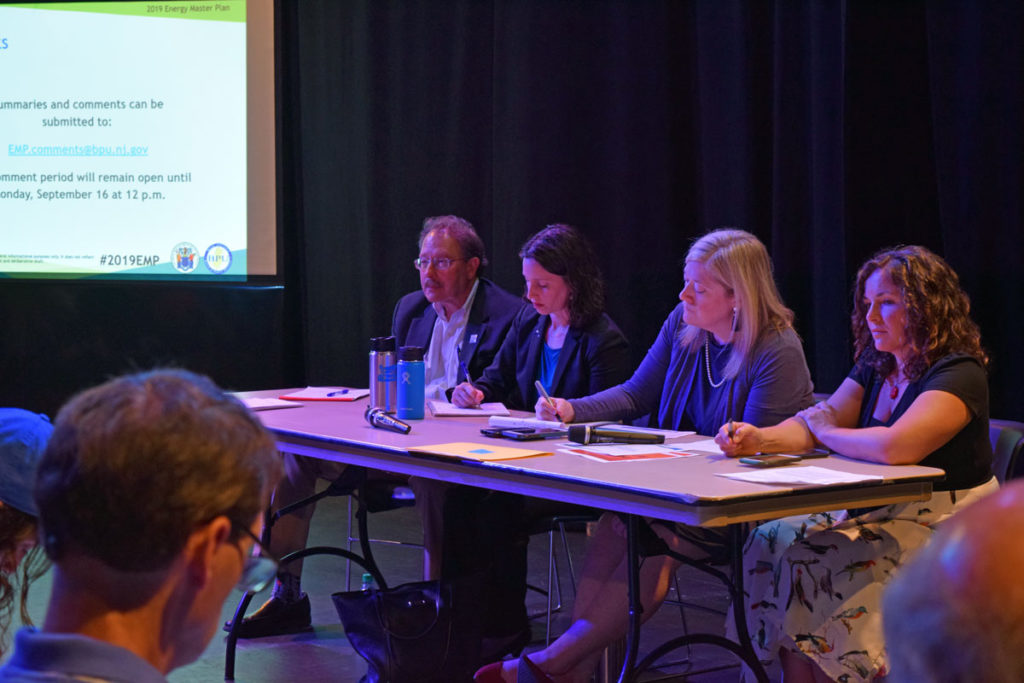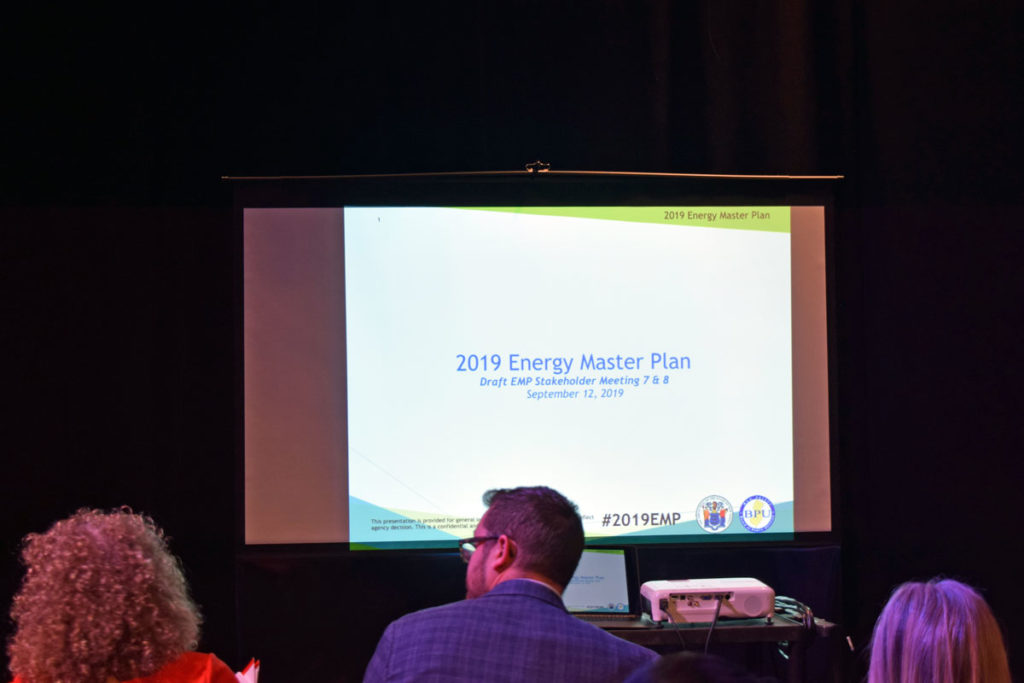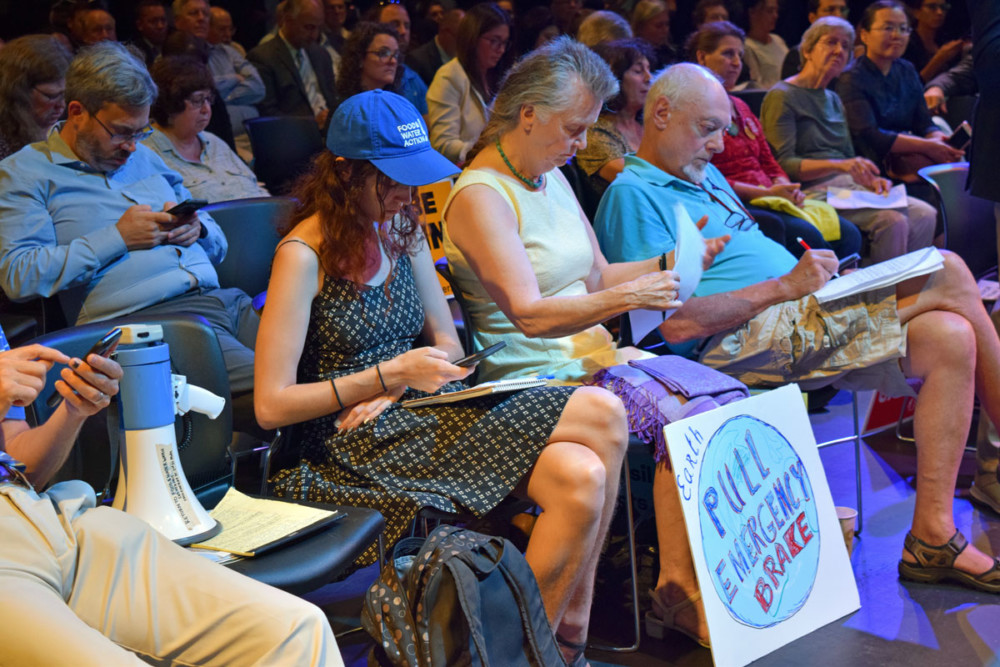
New Jersey is taking steps to run on 100 percent clean energy by 2050. Sounds pretty great, right?
Well, not everyone thinks so.
In June, the State of New Jersey released the Draft 2019 Energy Master Plan (EMP), an initial blueprint for the New Jersey’s groundbreaking plan to completely clean up its energy profile by 2050 in the face of the global climate crisis. This summer, activists, corporate representatives and concerned citizens alike had the chance to voice their thoughts about the EMP at eight public stakeholder meetings throughout the state.
I went to one of those stakeholder meetings on Sept. 12 at The Kroc Center in Camden so you didn’t have to. Keep reading for a sampling of the passionate statements shared in the four-hour meeting.
But first, let’s dive into a little background on the EMP.
30 YEARS IN THE MAKING
New Jersey Governor Phil Murphy (Democrat), set the 2050 goal in Executive Order 28, which he signed in May 2018. In the order, he declares that the state must “shift away from its reliance on fossil fuels as a primary energy source and turn to clean energy sources” in order to slow the effects of the climate crisis.
While the goal is new, the EMP is not. The state passed a law in 1987 ordering the creation of an Energy Master Plan Committee, which is required to create an EMP every 10 years and to update it every three years. The EMP includes information on the “production, distribution, consumption and conservation of energy” throughout the state.
The plan was last updated in 2015. In his executive order, Governor Murphy ordered the committee to overheal the latest version in favor of one that sets the state on track to achieve his ambitious goal.
The Energy Master Plan Committee is headed by the New Jersey Board of Public Utilities (NJBPU) and includes senior staffers from each of the following government agencies: Department of Community Affairs, Economic Development Authority, Department of Environmental Protection, Department of Health, Department of Human Services, Department of Transportation, Department of Labor and Workforce Development, Department of the Treasury, and New Jersey Transit. Phew.

The committee held seven public hearings from September to October 2018, getting feedback on what a clean energy policy vision should look like, similar to how Philadelphia’s Office of Sustainability got public input for the “Powering our Future” energy report. Taking those perspectives into account, the committee teamed up to write the 2019 Draft EMP.
But like any draft, it’s a work in progress. The committee asked for even morefeedback after releasing the plan, hosting eight additional public meetings from July to September to let the community respond to the draft.
The final EMP will be submitted to the Governor and Legislature in December 2019.
INSIDE NEW JERSEY’S ENERGY MASTER PLAN

The 2019 Draft EMP is a whopping 108 pages. In it, the NJBPU, lead author of the plan, defines “clean energy” as total carbon-neutral electricity generation in the transportation and building sectors, in order to meet or exceed the greenhouse emissions reductions of 80 percent relative to 2006 levels by 2050, as set by the Global Warming Response Act, a law passed by the New Jersey legislature in 2019. This goal is similar to Philadelphia’s, set by Mayor Kenney.
The NJBPU lays out seven overarching strategies to achieving 100 percent clean energy by 2050. They’re listed below (along with a simplified summary for each):
- Reduce Energy Consumption and Emissions from the Transportation Sector.
- Plain English: Incentivize the use of electric vehicles and public transportation, while converting vehicles at ports and airports from diesel to electric power.
- Accelerate Deployment of Renewable Energy and Distributed Energy Resources
- Plain English: Ramp up the development of wind and solar power and make it easier to distribute that energy throughout the state.
- Maximize Energy Efficiency and Conservation and Reduce Peak Demand
- Plain English: Ensure that individuals and institutions use significantly less energy.
- Reduce Energy Consumption and Emissions from the Buildings Sector
- Plain English: Require that all new construction is net zero carbon.
- Modernize the Grid and Utility Infrastructure
- Plain English: Upgrade the state’s electricity grid to ensure it can handle increased electrification; limit the economic burden of increased electrification to ratepayers; and guarantee the replacement of gas utility pipelines currently leaking methane.
- Support Community Energy Planning and Action in Low-and Moderate Income and Environmental Justice Communities
- Plain English: Ensure all communities have equal ability to: produce their own clean energy, access clean transportation options and participate in the clean energy economy.
- Expand the Clean Energy Innovation Economy
- Plain English: Support in-state research and development to ensure that the switch to clean energy boosts New Jersey’s economy and creates green job opportunities.
If you want to read the full plan in all its glory, with more details on how the committee intends to pull all this off, you can find it here.
THE COMMUNITY HAS ITS SAY
The public stakeholder meetings took place on the following dates, in the following locations:
- Meetings one and two on July 17 in Trenton
- Meetings three and four on Aug. 8 in Newark
- Meeting five on Sept. 3 in Hackensack
- Meeting six was on Sept. 5 in Toms River
- Meetings seven and eight on Sept. 12 in Camden
Those interested in voicing their opinions submitted written online comments and presented a three-minute version at a public stakeholder meeting. To guide the discussion, the NJBPU posed questions to stakeholders in the EMP about how it can achieve each of the seven strategies.
For example, for Strategy 3, the NJBPU asks, “How can the state ensure equitable access to and benefit from energy efficiency programs for all residents?”
Stakeholders submitted over 400 written comments. You can read them all here.
At meeting seven on Sept. 12, more than 70 people spoke, according to the NJBPU. The stakeholders who attended ranged from representatives from the natural gas industry, advocating for the use of natural gas as a low-carbon alternative to coal, to concerned citizens, shifting the conversation to allegations that the state’s primary energy provider, Public Service Enterprise Group (PSEG), frequently shuts off utilities in the homes of low-income New Jersey residents who can’t afford to pay their bills.
SO HOW DID THE PUBLIC REACT?
Some of the most compelling statements came from those who support the EMP’s goal to convert to 100 percent clean energy, but disagree with how the NJBPU plans to achieve it.
Hitting the wallets of older adults: Increased rates will harm vulnerable communities
Evelyn Liebman is the director of advocacy for AARP New Jersey, a nonprofit that works to enhance the quality of life of New Jersey residents aged 50 and over.
According to Liebman’s statement, the EMP will drastically increase home energy rates for all New Jersey residents, with a particular strain on senior citizens. As stated in the Choose Energy Rate Report, New Jersey already has some of the highest energy rates in the country. From a scale of 1 to 50, with 1 being the state with the lowest rates and 50 being the state with the highest, New Jersey ranks 39.
“Older adults spend a far greater proportion of their income on home energy costs than those in younger households,” Liebman said. “Studies also routinely show that older people limit or do without food, medical services and prescription medicine to pay for higher energy bills.”
Liebman emphasized that AARP supports the overall objective of the EMP, but the organization urges that the next iteration of the plan clearly state the projected costs of its activities, to make clear how it will impact the most economically vulnerable New Jersey rate payers.
Environmental groups: It’s not ambitious enough
Several speakers expressed support for a conversion to clean energy, but felt the timeline set by the 2019 Draft EMP does not sufficiently address the urgency of the climate crisis.
Jocelyn Sawyer (below, far left) is the New Jersey organizer for the Food and Water Watch, an advocacy group encouraging grassroots mobilization to address pressing food, water and climate issues. In her comment, Sawyer urged for the plan to aim for 45% emissions reduction from 2010 levels by 2030, or a 100% renewable, clean energy profile by the same year.

This goal is also endorsed in the 2018 Special Report on Global Warming of 1.5 °C, put out by the Intergovernmental Panel on Climate Change (IPCC). The report states that if the world wants to limit the most catastrophic consequences of the climate crisis, it needs to limit global warming to 1.5°C by 2030.
“If we don’t hit this target in the next 11 years, it will make little difference what happens between 2030 and 2050,” she said. “The scale of the genocide will already be set.”
Cheap pipelines with high costs: Natural gas can’t be part of the equation
The 2019 Draft EMP presents natural gas as a preferable alternative to coal and other fossil fuels. However, several speakers called for a moratorium on the construction of natural gas projects, an energy source that still emits greenhouse gases, even though it does so at lower rates than coal.
One of those speakers was Rhyan Grech, policy advocate at the Pinelands Preservation Alliance. She denounced the New Jersey Natural Gas’s Southern Reliability Link (SRL), a natural gas pipeline that is currently being constructed through the Pinelands National Reserve, a vast collection of forest, farms, wetlands and historic villages in New Jersey. Instead, Grech said, the EMP should prioritize the protection of the forest within the Pinelands, since it sequesters carbon.
“If the path to 100 percent clean energy is electrification, as laid out in the EMP, it is clear that fossil fuels and their infrastructure, like the SRL, are of the past,” she said.
Grech also cited a 2019 study by the Rocky Mountain Institute that found that by 2035, over 90 percent of proposed combined-cycle gas plants, if built, would be uneconomic to run compared to the cost of building a new clean energy portfolio.
“When discussing sustainable, renewable energy, a false narrative often pits economic interests against environmental concerns,” she said. “This fallacy that planning for renewable energy is more expensive than from fossil fuel sources leads to tentative goal setting, reluctant transition plans, and dragging of the feet in making bolds investments that lead to cleaner, and yes, cheaper, ways to power New Jersey.”
This story was produced in collaboration with the New Jersey Sustainability Reporting Hub project. It was originally reported by Brianna Baker for Green Philly, and may be re-distributed through the Creative Commons License, with attribution.
